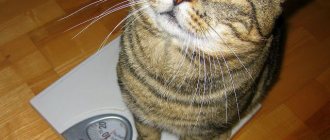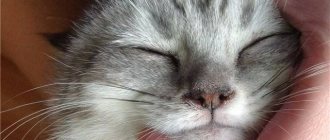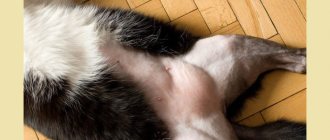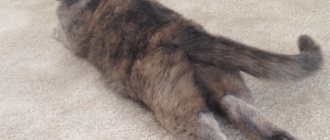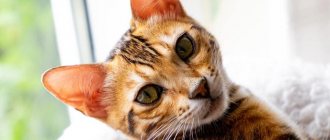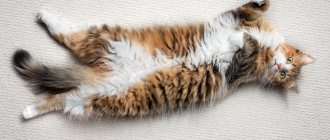5748Pavel
4
Often, owners do not pay attention to the temperature of their pet’s paws. Does your cat have cold paws? But this can be an important sign of the animal’s distress, especially if this symptom manifests itself for quite a long time.
Of course, you shouldn’t worry about why your cat has cold paws and assume the worst. If the tips of your cat's paws are constantly getting cold, you should first understand the cause of this condition. This will help prevent negative consequences in the future.
© shutterstock
At a doctor’s appointment, the cat’s owner will most likely remember when, what and how his beloved cat ate, when and how much water he drank, but at what time his paws began to become cold is unlikely. The veterinarian should be provided with detailed information, which is why it is necessary to monitor your pet carefully.
You need to know that in cats, body temperature changes quite seriously over 24 hours. The amplitude can be more than one degree. Therefore, it is difficult to track exactly when a cat’s paw pads became colder than usual. Nevertheless, it is worth trying, diagnosis and help depend on it.
What is the normal state of the animal?
Domestic cats and dogs living in city apartments have very sensitive paws throughout their lives. Cats that are used to walking a lot in the open air, and even more so those living in the yard or even homeless animals, have paws that are little susceptible to both cold and heat. As the pads of their limbs hardened, the nerve endings became more resilient. Therefore, the temperature of the paws of cats living outside and at home is slightly different to the touch.
However, the normal temperature of the paws is cooler than the body. However, they must be warmer than the environment, even if the cat walks in the snow.
While sleeping, your cat's paws become hotter. Because in a state of complete rest, when the animal lies down and all the muscles relax, the immune system works powerfully. And this, in turn, affects the overall body temperature of the animal, increasing it. Cats sleep 18 hours a day. Sleep gives way to drowsiness - this is a state when the mind is active and the body is relaxed. At this moment, the paws become a little cooler.
How to warm a cat's paws
As written above, your task is to determine the base body temperature and if it is normal, but the cat’s paws are still cold, you need to try to warm them. First, evaluate how warm it is in the home and how the pet behaves:
- Does the cat walk on the floor or prefer to move on the top? The higher you go, the warmer the air. Perhaps your pet is freezing?
- Perhaps the cat was moulting and the weather suddenly got colder - our pets are warmed by the undercoat, not the guard hair.
- Does your pet climb into your bed to sleep? If so, she looks for additional sources of heat .
The best option is an insulated house with a thick backing . Recently, recommendations have appeared on forums about insulating houses with heat-insulating fabric. Yes, it doesn’t look very attractive, but you can’t lure cats out of their warm nests.
Note! During sleep, the temperature and heat transfer of a cat’s body increases, therefore (if the house is cold) the pet may freeze in its sleep.
What factors cause a cat's paw temperature to drop?
The thermoregulation function is vital for all living organisms, including cats. Healthy, full-fledged animals do not need to carefully monitor the temperature of their paws. But older individuals and kittens need observation. Because their thermoregulation is weakened due to age and condition of the body. Therefore they need special care.
© shutterstock
The speed of metabolic reactions in the body is the basis of thermoregulation. Moreover, if the carbohydrates that a cat absorbs with food are broken down quickly, then its body will have a higher temperature.
However, there is an exception to this natural rule:
- In older cats, the rate of carbohydrate metabolism is reduced.
- Small kittens have a high metabolism, but it involves a small amount of carbohydrates. It is simply different in its chemical composition.
- You need to pay attention to hairless breed cats. After all, they do not have the ability to sufficiently control heat exchange with the environment, since there is no wool. Therefore, even in a warm house, this cat should be dressed in overalls.
If the cat is in a cool room, then, naturally, the temperature of the paws should be colder than usual. Especially if the animal starts to doze.
However, when it gets too hot, the paw pads also become cool. The fact is that cats have special glands, similar to sweat, deep between their toes, which can, if necessary, release moisture. This mechanism allows you to compensate for increased body temperature during extreme heat. Because moisture evaporates, cooling the skin. Long-haired and short-haired cats “sweat” equally. However, this phenomenon is more noticeable in individuals with short hair.
Non-hazardous reasons
Any animal survives using thermoregulation . This function does not work fully in kittens and older animals, but adult, healthy pets (usually) do not need help. Thermoregulation depends on the metabolic rate; the faster carbohydrates are broken down, the higher the body temperature.
If the room is cool and your cat is napping, her paw pads will be a little cooler than usual. This phenomenon is quite normal, considering that pet purrs are descended from wild animals that eat and sleep when they are lucky.
Note! Hairless cat breeds are not able to fully control thermoregulation. In the natural habitat of such animals there are no sub-zero temperatures, so even when living in a warm apartment, naked cats need to be clothed.
There is also the opposite option - heat and physical activity also lead to cooling of the paw pads . This happens because there are glands between the cat's toes that secrete fluid. Roughly speaking, a cat sweats its paws , the sweat evaporates and cools the skin. In long-haired pets, such phenomena are almost unnoticeable, since the liquid remains on the fur and practically does not cool the body.
Important! When a cat sleeps, it should have warm paws, especially the pads of its toes.
Should you measure your cat's body temperature?
Cold hind legs, ears and nose - this condition indicates that the animal’s overall body temperature has decreased.
© shutterstock
If you feel that not only the paws, but the entire body of the animal has become noticeably colder than usual, be sure to measure the temperature. If the reading is below normal - 38 degrees, you should immediately contact your veterinarian.
In this case, you cannot waste time, because there can be many reasons for an abnormal decrease in a cat’s body temperature. Only a doctor can establish an accurate diagnosis and help your pet. Letting the situation take its course or self-medicating is unacceptable.
How to help an animal?
If an examination by a veterinarian does not determine the disease, the pet is completely healthy; the only thing that can be done to get rid of the unpleasant sign is to prevent hypothermia. If possible, avoid walking in cool weather or carefully insulate the animal. If your cat has cold ears and nose after returning home, carefully examine the animal for frostbite.
At the first signs of frostbite, try to warm your pet with warm compresses. If the damage to the skin is mild, several applications of a regenerating and anti-inflammatory cream (Levomekol or Panthenol) are sufficient. In case of serious lesions, only timely contact with a veterinarian and effective treatment will help.
If the problem appears during pregnancy, it is recommended to regularly visit a veterinarian for preventive examinations. Usually the sign disappears immediately after the kittens are born, but if this does not happen, you will have to undergo a more thorough examination.
Cold ears on an animal are not always a cause for concern, so you will have to carefully examine the cat and observe its behavior. This symptom is usually harmless, but it is better not to neglect a preventive examination, which will allow you to identify even hidden diseases.
This is interesting: Prazicide suspension for kittens
Causes of limb failure in cats
There are many reasons for mobility impairment in cats. It is almost impossible to independently determine what the hind legs gave up. An accurate diagnosis and correct treatment can only be prescribed by a veterinarian, after conducting the necessary tests and a full examination of the cat. Failure of a cat's hind legs is a reason for urgent action.
Experts identify many reasons why a cat’s hind legs fail. The cat's movement may become impaired for the following reasons.
- Spinal injury in the lumbar region. It occurs more often in cats that roam freely on the street and may be hit by a car. There is also a high risk of such damage if the cat falls from a great height onto a hard surface. At home, spinal injury cannot be completely ruled out. With such an injury, in addition to the cat’s paws, the mobility of the tail is also impaired, since the lumbar spine, which is responsible for the mobility of the entire lower part of the body, is damaged. Possible general weakness.
- Thromboembolism. A dangerous condition that occurs due to blockage of the femoral artery by a blood clot. In such a situation, the cat experiences acute pain in the lumbar region and therefore begins to bite this place strongly. She also meows loudly due to pain. At first, the paws do not completely fail, and the cat only drags them when moving. Soon, as the tissues become necrotic, the paws become completely paralyzed and become cold. If help is not provided to the cat in the next 2 hours, then in most cases the cat dies within 2-3 days. If the pet has received the necessary therapy, then it is even possible to completely restore the mobility of the limbs. It is impossible to start treatment on your own.
- Spinal cord injury, traumatic and non-traumatic. With this disorder, the cat's paws are taken away and all sensitivity is lost. Gradually, if treatment is not started, the tissues begin to atrophy and completely lose their functions. Restoring paw mobility is not always possible, and in some cases the animal requires a stroller for normal movement. The device is attached to the animal in a special way, and the cat moves with its front paws, while the back of its body rides in a stroller. Hind legs raised.
- Tick paralysis. A very dangerous disease that leads to 100% mortality if treatment is not started within 24 hours after the first symptoms of the disease appear. Pathology occurs when a cat is bitten by ixodid ticks, which produce special substances that poison the cat’s body. At first, the animal behaves extremely excitedly. Then apathy develops and paralysis sets in, and the paws fail. The cat trembles and reacts poorly to external stimuli. There is a chance to save the cat only if you start treating it at the moment of excitement. If the paws fail, it’s too late.
- Inflammation of the spinal cord. Myelitis occurs due to infectious lesions, helminthic infestations, poisoning with heavy metal salts, injuries and autoimmune reactions. In such a situation, in addition to the fact that the paws fail, the cat experiences a general increase in temperature, urinary incontinence and digestive problems. If treatment begins immediately after the onset of symptoms of the disease, then restoring the mobility of the cat’s limbs is quite possible. In older animals, most often the restoration of mobility is not complete, but satisfactory.
- Hip dysplasia. Large, heavy animals such as Maine Coons and Chartreux cats are prone to this disease. With this pathology, a violation occurs in the development of the joint. As a result, the cat experiences severe pain when moving, which causes the pet’s gait to change. The cat walks, weaving and placing its hind legs uncertainly, and tries not to jump. If sick animals have to jump onto a bench or chair, they often fall over on their side and meow because of the acute pain that arises. Treatment is only supportive.
If problems arise with the limbs, the cat should be immediately shown to a veterinarian. The most possible diagnosis is trauma. You need to find out in detail how to treat a cat’s paws from a veterinarian. The causes of paralysis in cats are varied and the owner needs to know about the main ones.
There are many diseases that can cause loss of a cat's hind legs. There are many reasons for this, once you identify them, you can begin treatment. To do this, the veterinarian carries out laboratory and instrumental diagnostic methods and a general examination. The prescribed therapy should be strictly adhered to, and self-medication should not be resorted to, since paralysis is dangerous for the cat.
Types of colors
The main types of coat color of the Abyssinian cat:
- classic wild;
- blue;
- sorrel;
- faun.
In addition to the four main colors included in the breed standard, there are other types of colors of Abyssinian cats:
- lilac;
- brown;
- tortoiseshell;
- black.
Black Abyssinian cats are spectacular and elegant. Despite the fact that this color is not included in the standard, they are popular.
In fact, the fur of these cats is dark chocolate or black-gray. The belly is lighter - gray or brown.
It is difficult for breeders to achieve the consolidation of black color in the color, because there are very few Abyssinians with black ticking.
Classic wild color
At first, this color was the only color standard for the Abyssinian cat breed. Today this is the most common and popular shade. It contains rich ocher, brown, and black tones.
Compliance with standards is determined by the following parameters:
- ticking must be uniform, at least 3 segments;
- the sides and back are painted a darker ocher-brown color than the lower part of the body;
- the paws have black fringes;
- a black stripe runs along the entire length of the ridge;
- the nose is terracotta-colored, clearly defined;
- eyes the color of gold, walnut, emerald.
Different degrees of shade intensity are allowed
It is important that no extraneous colors are mixed into the base ones.
Sorrel
Sorrel translated from English means “bay, red.” This color is warmer than the classic one; it is dominated by red shades of wool, the color of copper, apricot, and chocolate.
Characteristics:
- the main ticking background can be of two types: dark chocolate or cinnamon color;
- The presence of black hairs in the wool is unacceptable;
- the tummy and paws are colored apricot on the inside;
- dark stripe on the spine and tail;
- the pale pink nose is outlined in red;
- paw pads pink-beige;
- eyes are the color of gold and copper, greenish or dark hazel shades are acceptable.
Blue
This type of color was approved relatively recently. The name of the suit was given by a delicate smoky blue tint. The combination of pearl, beige and slate gray shades in the ticking segments gives an unusual effect.
Standard requirements for an Abyssinian blue cat:
- on the frontal part of the muzzle there is a pattern similar to the tails of a tailcoat;
- on the lower part of the body from the chin to the tummy, the color of the coat is light beige and apricot tones;
- along the ridge there is a narrow stripe of a tone more saturated than the main color with a pronounced bluish tint;
- the nose is blue-gray or terracotta in color with a clear dark outline;
- paw pads pale pink;
- the undercoat should be lighter than the base color, but not whitish;
- eyes are golden, copper in color, less often green or hazel.
Faun
Translated from English, faun means fawn. This is the rarest shade of the Abyssinian cat. The color is similar to sorrel, but less intense.
The exquisitely colored Abyssinian fawn cat is incredibly elegant. Thanks to her plasticity, she looks like a lioness and is graceful like a deer.
Color characteristics:
- ticking with segments of coffee, cream, beige, chocolate with milk color;
- along the spine to the tip of the tail there is a stripe of a rich pink-beige hue;
- the undercoat is lighter and brighter than the main color;
- the pink nose is outlined with a reddish outline;
- the belly and paws are covered with gray-beige fur;
- Eye color must comply with breed standards.
The owners of Abyssinians are firmly convinced that the character and temperament of a cat depends on its color:
- wild ones are proud, independent and extremely intelligent;
- sorrel - cheerful and perky;
- fauns and blues are gentle and sensitive.
Signs of hypothermia
There are a number of main signs of hypothermia in cats that are easy to notice:
- trembling – when a cat is cold, it begins to tremble. This is a natural way to generate heat, writes DailyPaws;
- cold paws, tail, nose and ears. Without normal blood flow, their risk of frostbite also increases;
- pale or gray gums.
When a cat is trying to conserve body heat, it may stop looking for a source of heat and curl up in a ball. At this stage, the animal may experience mild hypothermia. As it becomes more severe, your heart rate and breathing slow down. A cat suffering from severe hypothermia may lose consciousness and go into a coma.
Prevention
When planning mating, it is recommended to check the health of the female and male. Adult cats should be protected from injury and poisoning. As a preventive measure, it is necessary to maintain a high level of immunity, monitor the quality of nutrition, and promptly treat viral and infectious diseases. If a kitten or adult cat exhibits symptoms of ataxia, you should not self-medicate or expect the condition to normalize on its own. Sometimes vestibular disorders can be the result of dangerous internal pathologies, the timely treatment of which affects prognosis and recovery.
Diagnosis of paw paralysis
If the initial examination is not enough to determine the cause of paw paralysis, then the following diagnostic methods are used:
- determination of neurological reactions;
- X-ray of the spine and affected limbs;
- Ultrasound of the abdominal cavity;
- detailed blood and urine analysis;
- taking smears for bacteriological analysis;
- MRI and CT scans of areas of the body where pathology is suspected to exist (spine, abdominal cavity, brain);
- determining the level of sensitivity of the affected limbs.
Reasons why a cat falls
Paralysis and paresis of the limbs can be associated with infectious and inflammatory lesions, impaired blood supply, spinal cord or brain injury. In this case, the animal will also experience other neurological symptoms (nystagmus, fainting, behavioral disturbances, different pupil sizes). If the spinal cord in the pelvic area is affected, the cat may have trouble urinating and defecating.
The cat's paws may begin to move apart, then the cat may fall over on its side due to tumors of the spinal cord. The same symptoms can occur with alimentary hyperparateriosis.
Muscle weakness can be caused by various myopathies (for example, caused by potassium deficiency), infectious diseases (viral infection, damage to protozoa). For example, muscle weakness is one of the earliest symptoms of botulism in a cat.
An animal may fall from exhaustion or as a result of heavy blood loss. Bleeding may be internal, so it is not immediately diagnosed. At the same time, the cat is lethargic, refuses food, falls asleep, its limbs are cold, the mucous membranes are bluish.
Ataxia (coordination disorders) can be congenital or acquired. There are several types of this disease in cats.
The main ones include:
- vestibular;
- cortical;
- cerebellar;
- sensitive.
With ataxia, the animal has a staggering gait, it places its paws uncertainly, as if it does not know where or how to lower the limb.
